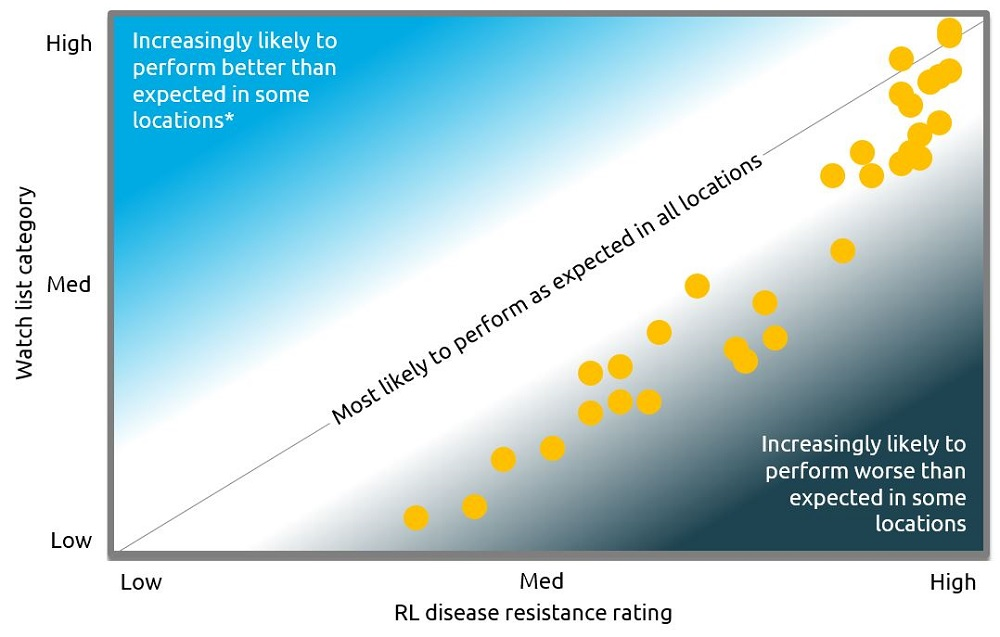Wheat yellow rust: disease ratings, monitoring and control
Friday, 19 March 2021
The constantly changing wheat yellow rust pathogen population has resulted in numerous slips in varietal resistance over the last decade. AHDB Crop Protection Scientist Catherine Harries explores how the industry has adapted to the evolving threat.
The speed at which the pathogen behind yellow rust (Puccinia striiformis) is able to change has forced a management rethink – from varietal development to field control.
The Recommended List (RL) disease ratings indicate a variety’s potential to withstand attack from this important foliar pathogen. However, as these struggled to keep up with the shifting pathogen pressure, we overhauled the system for the current edition (RL 2021/22).
Yellow rust ratings: What’s changed?
Weighted rating
Typically, up until the 2021/22 edition of the RL, an average of the previous three years’ trials data was used to calculate the rust ratings.
For relatively stable pathogen populations (such as with septoria leaf blotch), this is a good approach. However, when pathogen populations are relatively changeable – such as with yellow and brown rust – it can result in misleading ratings.
Now we give a higher weighting to yellow and brown rust trial data from more recent years. This means the ratings are much more sensitive to pathogen population change. If a variety becomes more susceptible over the three years, the rating now reflects that.
Reset slope
It is not just about ‘boom-and-bust’ changes to resistance. In fact, gradual changes in the yellow rust population have resulted in gradual changes to the performance of varieties. Over time, this resulted in a ‘slippage’ of variety ratings – for example, a variety with 10% disease would have received a rating of 4 in 2012, but 5 in 2019.
We addressed this by ‘resetting’ the ratings. This one-off change has caused the ratings of many varieties to fall. It is important to know that this does not necessarily mean the variety has become more susceptible to yellow rust; it may purely be down to the reset calculations.
Watch list
Earlier this year, we introduced the yellow rust watch list to highlight varieties that may be susceptible to relatively uncommon races of yellow rust. We calculated a rating based on disease levels in the worst three trials for each variety and ranked varieties based on this rating. These rankings can be compared with the main RL disease rating to show if any varieties are performing out of line.
While we will never be able to predict race changes, or the effect these might have on varieties, the watch list does, at least, provide a ‘best guess’ at which varieties need closer monitoring.
As only three data points go into the watch-list variety ranking, anomalous results can have a big effect. It is important to be aware of this and know that the main RL rating best represents average variety risk, across the season and across the UK.
Young-plant and adult-plant resistance to yellow rust
Due to the nature of yellow rust resistance, various genes operate at different times in a crop’s life. RL yellow rust ratings reflect disease levels at the adult-plant stage only (after growth stage 55).
At the young-plant stage (generally considered to be before growth stage 55), most RL varieties are susceptible to yellow rust. However, this period includes the key T0–T2 fungicide timings. As a result, we also publish information on which varieties are resistant and susceptible at this stage on the watch list. This uses data from the UK Cereal Pathogen Virulence Survey (UKCPVS).
Management of yellow rust in 2021
At present, the watch list rankings agree fairly well with the main RL disease ratings and there are no varieties to be particularly concerned about in 2021. However, since yellow rust is much easier to control if it is caught early, we recommend closely monitoring all varieties. If the variety has a good rating, it is likely disease levels will reduce as the season progresses. However, this can never be guaranteed, so prompt fungicide application is important, when the yellow rust pressure justifies it.
If you see anything that performs out of line with the main RL rating, please send a sample to the UKCPVS for analysis.
Further information
Wheat and barley disease management guide
How to score disease symptoms in wheat video
Crop selection and variety performance (webinar)
‘Interesting’ wheat yellow rust isolates identified by UKCPVS (article)
 AHDB
AHDB
What is the watch list? (video)
AHDB Crop Protection Scientist Catherine Harries explains how to use the list to help understand disease risk
Disease rating v watch list category
 AHDB
AHDB
Close alignment between the RL disease resistance rating and the watch list category means a variety is most likely to perform as expected in all locations. The above chart is for illustrative purposes only. The coloured variety dots indicate the approximate relationship between the watch list and the RL disease ratings (RL 2021/22).

Topics:
Sectors:
Tags:

